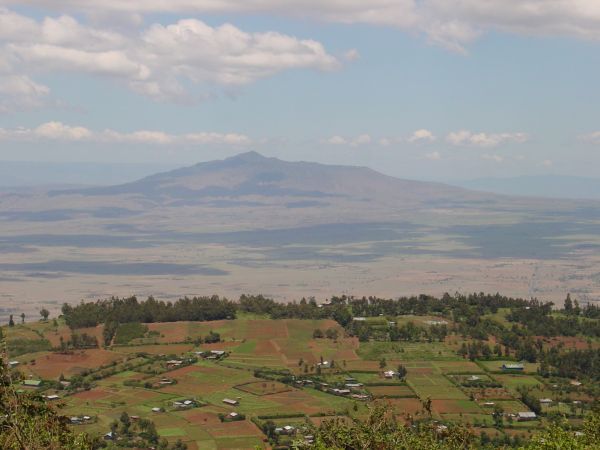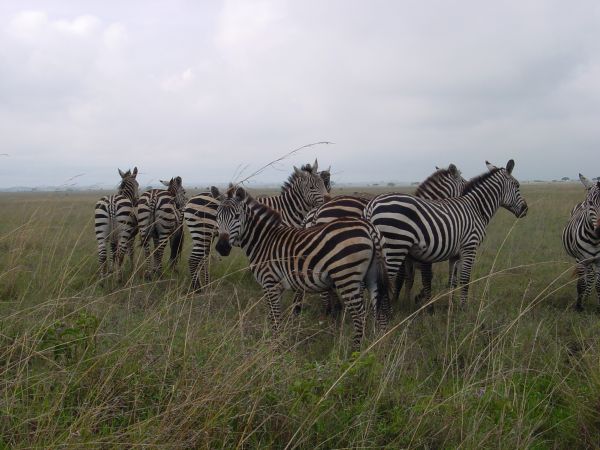Question:
I was referred to you concerning my interests in the Maasai people. I understand you worked with the Maasai people of eastern Africa. Where within the population did you serve?
Answer:
I was in the Suswa-Longonot area of the Great Rift Valley in Kenya. This is the Suswa District of Rift Valley Province. Suswa and Longonot are small inactive volcanic mountains in the Rift Valley near the main east-west highway across Kenya about an hour's drive northwest of Nairobi.
The Panafrican Highway runs from Nairobi to Nakuru and on northwest to Kisumu before passing into Uganda on its westward trek. We turned off this highway on what was called the Narok Road. This road runs west past Mt Suswa and Suswa District, on to Narok then out to the Maasai Mara Game Preserve.
My main contact area there was the village of Oloirowua. From there we connected through the natural social and lineage network to the hills and plains around there. We had groups (churches) meeting in the towns of Naivasha and Nairage-Engare in Suswa District and there was at least one other group in the next district town of Narok, administrative center of Narok District.
The people of Suswa were of the sub-tribe of Keekonyokie Maasai. There are about 10 (some say 9) sub-groups of the Maasai, who have somewhat different characteristics and language differences. They differ in the kinds of colours and patterns in their beads and dress.
|
Question:
What was the focus of your ministry and other ministries focused toward the Maasai people? i.e., youth, sports, Chronological Bible Storying, Church planting, etc.
Answer:
Broadly, of these categories you mention, I guess it would fall in the Church Planting category you mention. (I've never liked the term "church planting." It sounds mechanical and impersonal, and tends to promote a focus on institutional factors more than relational factors.)
But method or approach was not the priority. The strategy and "approach" was simply building relationships and becoming a part of the community. My colleague Herb Cady got involved in some water projects in the area. He worked with the government authorities and water specialists to get some water catchment and distribution systems in.
"Storying" was only just then beginning to develop as a technical method. But I had been telling stories since I first went to Kenya in 1971, when I saw how the African peoples used stories. "Storying" arises out of the character of Orality in relational cultures around the world. The focus of such cultures is on oral and interpersonal communication, not on abstract information as we find in the western analytical society and its focus on written communication. Relational values are primary, not information.
|

Mt Longonot, Rift Valley Province, Kenya
|
Narrative is critical in communicating with African peoples. But stories and life-narratives always have meaning in interpersonal relationships, not abstract information. The Bible is written in stories, not as a dissertation of facts and information or a historical analysis. The format of the Bible itself is very different from the recent modern approach to it.
This was totally new work, in terms of churches. Various levels of contact had occurred in the area from 1971 or so, when I myself was going out there with a mission doctor, initially just once a month I think it was.
I began making regular contact in mid-1985, after some new personnel visited with the Suswa folks as they traveled through. Some of the local people there told them they wanted to "start a church."
Of course, they did not know what that meant, but they associated "church" with school, or wells, or other "modern" opportunities. In earlier times, the Maasai had been indifferent or opposed to such change. But matters had changed rapidly in the late 70s and 80s due to extended droughts and the resulting worsening of land conditions.
Additional problem factors were increased population all over Kenya, and the government's new plan to settle families into family villages called Group Ranches. In the first year I worked with Oloirowua and neighbouring villages (in about a 5-10 mile radius), they planted their first Maize (corn) crop.
The primary "method" was spending time with them and talking about life, sharing our stories. Of course we also met to sing and read from the Maasai and Swahili New Testaments. I would preach, using what Maasai I could as I learned, and my Swahili was interpreted through Maasai Christian interpreters.
I worked there only about three years, working part-time (though almost every weekend over three years). I brought on another part-time missionary after a while, school principle Herb Cady in Nairobi, who had visited and became interested when he and his wife Becky first came to Kenya. After about a year, Herb transferred to the Suswa work fulltime, though I continued to be responsible for the work I had started.
I then gradually turned the work over to him. He established new work, mentored new missionaries and developed Maasai leaders. He later went on to work in the Samburu area in what had been called the Northern Frontier, in even more deprived climatic conditions.
|
We worked informally, fostering the Maasai to learn and develop their own faith and make their own decisions about needs like buildings, local practices, organization and positions of service established, when they brought up the questions.
I just encouraged them to talk and think about that, why they wanted it, what it would do, how they would pay for it, etc. We studied Acts and the letters of the New Testament and they considered how that related to their culture and living situation.
Thus the focus from the beginning was on an indigenous faith community in each village and the broader fellowship through their natural social networks. This was the pattern of new church starts. We worked to learn their worldview, their concerns and needs, and openly discuss personal beliefs and commitments in a very natural informal atmosphere, as well as with larger group addresses.
We were invited to meet under the main tree in the Suswa area near the village of Oloirowua, where major community meetings were held. Everything was open and visible to the whole community, handled as they commonly handle any business.
We conducted the first baptism about 6 months after beginning, and after about 10 months, had 7 churches in different villages. These were all working under community and local leadership direction. The missionaries did not run the churches, as they do in some organizations we have commonly observed in East Africa.
|

Large herds of Zebras were commonly seen all over the plains of the Great Rift Valley.
|
After about one year, the new Suswa Baptist Association of churches was recognized as a cooperating association of the Baptist Convention of Kenya.
These were not missionary churches, and no missionary was a pastor, though we were the mentors and trainers or teachers. I did not focus on structures and systems, except we conducted leadership training sessions, mostly Bible study and discussion of practical questions that arose in the church and community.
Everything was interactive, and teaching was done through interactive discussion. Decisions were made by the elders/leaders in each community, after a discussion of the factors involved and a look at some biblical situations where a similar matter may have come up.
This was interactive, question-answer style, though centered around a biblical passage or topic I planned. But the agenda was flexible and practical, because this was about following Jesus, not about learning information or implementing pre-determined structures.
Question:
What are some current barriers and bridges that you see in the work with the Maasai?
Answer:
Bridges: The Maasai have a traditional concept of one Creator God whom they pray to. Their traditional prayers reflect a similar concept of God as the biblical God, but they lack a traditional concept of close relationships with God and interpersonal activity of God in daily life. We closed the prayers with the traditional prayer formula "Eesai" equivalent to "Amen" ("may it be so") borrowed from Hebrew.
They responded well to the idea that God came to earth in a human life, Jesus. They expressed excitement that Jesus was a divine presentation in human life in a real human tribe, in a specific country of the world, at a certain time in history, a person with a tribal (human) identity like them!
This made sense to them, and the Good News was personal and viable to them. They really accepted the story of Jesus and found it easy to believe that he was the Son of God for them.
Barriers: I do not recall any great ones. There was some difficulty of some older generation folks to understand exactly what was happening and how to understand Jesus. We had good relationships in the community, and a good working relationship with the chief of that region. (Chiefs are central-government-appointed representatives for a geographical region, and usually come from the dominant ethnic group of that region.)
The Maasai, like East African peoples in general, are very hospitable and welcoming, though cautious and observant of newcomers and new ideas. The people of Suswa were of a progressive mind. They invited us to come work among them.
The Maasai are very open and expressive about their observations, ideas and concerns. Very different from the Bantu peoples. It was easy to tell where we stood, and to address matters of concern or uncertainty when they arose. The Maasai are problem solvers.
Orville
More about Suswa:
![[TXT]](../graphics/text.gif) The Flying Kid
The Flying Kid
![[TXT]](../graphics/text.gif) Indigenous Churches – an Adventure of Discovery (Baptist Church Status among the Keekonyokie Maasai of Suswa, Kenya)
Indigenous Churches – an Adventure of Discovery (Baptist Church Status among the Keekonyokie Maasai of Suswa, Kenya)
![[TXT]](../graphics/text.gif) "Not My People" Become My People
"Not My People" Become My People
![[TXT]](../graphics/text.gif) Suswa: An Evangelical Experiment (The Use of Natural Networks in Christian Evangelism)
Suswa: An Evangelical Experiment (The Use of Natural Networks in Christian Evangelism)
Also related
![[TXT]](../graphics/text.gif) Living and Working in Kenya
Living and Working in Kenya
![[TXT]](../graphics/text.gif) More Oral than We Knew
More Oral than We Knew
![[TXT]](../graphics/text.gif) The Mukogodo of Kenya
The Mukogodo of Kenya
![[TXT]](../graphics/text.gif) Orality, Literacy and the Bible
Orality, Literacy and the Bible
![[TXT]](../graphics/text.gif) Orality in Christian Mission
Orality in Christian Mission
![[TXT]](../graphics/text.gif) The Samburu of Kenya
The Samburu of Kenya
Also view related PowerPoint Presentations:
![[PowerPoint Presentation]](../graphics/projector.jpg) Assimilation Models – How People Groups Develop and Change
Assimilation Models – How People Groups Develop and Change
![[PowerPoint Presentation]](../graphics/projector.jpg) What is a People Group
What is a People Group
![[PowerPoint Presentation]](../graphics/projector.jpg) Oral & Literate Contrast Chart
Oral & Literate Contrast Chart
![[PowerPoint Presentation]](../graphics/projector.jpg) Orality and the Postliterate Society
Orality and the Postliterate Society
Related on the Internet:
The Great Rift Valley of Kenya
International Orality Network
Mt Suswa Exploring
"Storying"
Mt Longonot, former volcano - Wikipedia
Mt Suswa, former volcano - Wikipedia
Mt Suswa, former Volcano
Mt Suswa - Video
Superb video of the mountain and the people
"Storying"
Suswa - NTV on YouTube
OBJ
First written in answer to an email query in April 2010
Topic developed April-June, December 2013
Posted as a new article 31 December 2013
Last edited 16 February 2018
Orville Boyd Jenkins, EdD, PhD
Copyright © 2013, 2018 Orville Boyd Jenkins
Permission granted for free download and transmission for personal or educational use. Please give credit and link back. Other rights reserved.
filename: suswaapproaches.html


![[TXT]](../graphics/text.gif)